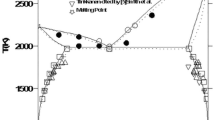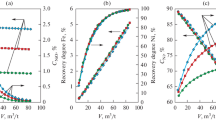Abstract
This study is a collection of both newly published and/or presented works on impurity capacity predictions in molten melts which were carried out by Derin et al. Some sulfide capacity prediction results of iron oxide containing ternary silicate melts and industrial lead and copper slags using the Reddy-Blander model and some impurity capacity predictions of multicomponent oxide and salt melts obtained using a Artificial Neural Network Approach are discussed.
Similar content being viewed by others
References
D.J. Sosinsky, I.D. Sommerville, The composition and temperature dependence of the sulfide capacity of metallurgical slags. Metall. Mater. Trans. B 17, 331–337 (1986)
J.A. Duffy, M.D. Ingram, An interpretation of glass chemistry in terms of the optical basicity concept. J. Non-Cryst. Solids 21(3), 373–410 (1976)
T. Mori, On the phosphorus distribution between slag and metal. Bull. J. Inst. Met. 23(5), 354–361 (1984)
R. Moretti, G. Ottonello, Solubility and speciation of sulfur in silicate melts: the conjugated Toop-Samis-Flood-Grjotheim (CTSFG) model. Geochim. Cosmochim. Acta 69(4), 801–823 (2005)
M.M. Nzotta, D. Sichen, S. Seetharaman, A study of the sulfide capacities of iron-oxide containing slags. Metall. Mater. Trans. B 30(5), 909–920 (1999)
R. Selin, Y. Dong, Q. Wu, Uses of lime-based fluxes for simultaneous removal of phosphorus and sulphur in hot metal pretreatment. Scand. J. Metall. 19(3), 98–109 (1990)
Y. Kobayashi, N. Yoshida, K. Nagai, Thermodynamics of phosphorus in the MnO–SiO2–FetO system. ISIJ Int. 44(1), 21–26 (2004)
X.M. Yang, C.B. Shi, M. Zhang, J.P. Duan, J. Zhang, A Thermodynamic model of phosphate capacity for CaO–SiO2–MgO–FeO–Fe2O3–MnO–Al2O3–P2O5 slags equilibrated with molten steel during a top–bottom combined blown converter steelmaking process based on the ion and molecule coexistence theory. Metall. Mater. Trans. B 42(5), 951–977 (2011)
B. Maramba, R.H. Eric, Phosphide capacities of ferromanganese smelting slags. Min. Eng. 21, 132–137 (2008)
M. Sasabe, S. Yamashita, S. Shiomi, T. Tamura, H. Hosokawa, K. Sano, Nitride capacity of the molten CaO–SiO2–Al2O3 system containing TiO2 or ZrO2 and equilibrated with Molten Si. Tetsu-to-Hagane 87(12), 727–733 (2001)
W.Y. Shin, H.G. Lee, Nitride capacities of CaO–Al2O3–CaF2 melts at 1773 K. ISIJ Int. 41(3), 239–246 (2001)
B. Derin, M. Suzuki, T. Tanaka, Sulphide capacity prediction of Molten slags by using a neural network approach. ISIJ Int. 50(8), 1059–1063 (2010)
B. Derin, E. Alan, M. Suzuki, T. Tanaka, Phosphate, phosphide, nitride and carbide capacity predictions of Molten melts by using an artificial neural network approach. ISIJ Int. 56(2), 183–188 (2016)
R.G. Reddy, M. Blander, Modeling of sulfide capacities of silicate melts. Metall. Trans. B 18, 591–596 (1987)
R.G. Reddy, M. Blander, Sulfide capacities of MnO–SiO2 slags. Metall. Trans. B 20, 137–140 (1989)
R.G. Reddy, Thermodynamic modeling of sulfide capacities of melts. Paper presented at 6th international conference on Molten slags, fluxes and salts, Stockholm, Sweden–Helsinki, Finland, 12–17 June, 2000
A.D. Pelton, G. Eriksson, A. Remero-Serrano, Calculation of sulfide capacities of multicomponent slags. Metall. Trans. B 24(5), 817–825 (1993)
Y.B. Kang, A.D. Pelton, Thermodynamic model and database for sulfides dissolved in molten oxide slags. Metall. Meter. Trans. B 40, 979–994 (2009)
C.J.B. Fincham, F.D. Richardson, The behaviour of sulphur in silicate and aluminate melts. Proc. R. Soc. Lond. A 223, 40–62 (1954)
B. Derin, O. Yücel, R.G. Reddy, Sulfide capacity modeling of FeOx–MO–SiO2 (MO = CaO, MnOx, MgO) melts. Miner. & Metall. Process. J. 28(1), 33–36 (2011)
B. Derin, O. Yucel, R.G. Reddy, Predicting of sulfide capacities of industrial lead smelting slags. Paper presented at TMS, Sohn International Symposium on Advanced Processing of Metals and Materials: Volume 1-Thermo And Physicochemical Principles: Non-Ferrous High-Temperature Processing, Catamaran Resort. San Diego, California, USA, pp. 237–244, 27–31 Aug 2006
B. Derin, R.G. Reddy. Sulfur and Oxygen partial pressure ratios prediction in copper flash smelting plants using reddy-blander model. Paper presented at Yazawa International Symposium on Metallurgical and Materials Processing, TMS, San Diego, California, USA, pp. 625-632, 02–06 Mar 2003
Acknowledgments
We acknowledge with great pleasure the financial support from Istanbul Technical University.
Author information
Authors and Affiliations
Corresponding author
Editor information
Editors and Affiliations
Rights and permissions
Copyright information
© 2017 The Minerals, Metals & Materials Society
About this paper
Cite this paper
Derin, B. (2017). A Review of Some Studies on Impurity Capacity Predictions in Molten Melts. In: Wang, S., Free, M., Alam, S., Zhang, M., Taylor, P. (eds) Applications of Process Engineering Principles in Materials Processing, Energy and Environmental Technologies. The Minerals, Metals & Materials Series. Springer, Cham. https://doi.org/10.1007/978-3-319-51091-0_50
Download citation
DOI: https://doi.org/10.1007/978-3-319-51091-0_50
Published:
Publisher Name: Springer, Cham
Print ISBN: 978-3-319-51090-3
Online ISBN: 978-3-319-51091-0
eBook Packages: Chemistry and Materials ScienceChemistry and Material Science (R0)




